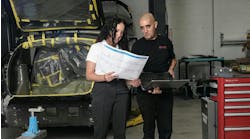Today’s vehicles are designed to be more fuel efficient and easier on the environment. Both of which have led to the increased use of aluminum in the production of vehicles in a variety of applications, from aluminum body panels to replacement parts. From a collision repair perspective, there are some things you should be aware of when working on aluminum body panels.
Working With Aluminum
Repairing aluminum body panels can be quite different than repairing steel. Aluminum is more prone to dents and scratches than steel, while steel is less likely to warp or bend from weight, force, or heat.* So, while a dent in mild steel may be able to be “popped” back to shape; repairing a dent in an aluminum body panel without damaging the surrounding area requires special skill and, in some cases, advanced repair techniques.
To learn these specific techniques, technicians can undergo specialized training in Toyota’s PB301A Aluminum Body Repair Techniques E-Learning course.
Precautions When Working With Aluminum
Here are some basic guidelines:
- Aluminum itself is corrosion resistant. If you are sanding metal (especially steel) and metal particles get on aluminum body panels, they can cause galvanic corrosion that causes the aluminum to corrode. To prevent this, tools and materials that come in contact with steel should be separated from those used for aluminum repair or cleaned and sterilized before they are used on aluminum.
- Prime aluminum substrates as soon as possible and no later than eight hours after cleaning steps.
- Aluminum is brittle and easily develops work hardening and cracks. Heating aluminum when restoring a deformed portion improves workability and prevents work hardening and cracking, so be sure to use the optimal heating temperature to provide the best results (the optimal temperature varies based on the type of aluminum alloy).
- When the structure of an aluminum panel has been hardened through damage, annealing can be used to repair the panel. This special process removes hardness through heating.
- Before performing repairs, heat the damaged area to approximately 392°F for 6000 series aluminum alloy and 482°F for 5000 series. Allowing the panel to then cool naturally helps eliminate the hardness in the panel and improves crack resistance and serviceability.
- Aluminum has good heat conductivity. To ensure heat does not spread to unwanted areas, cover the areas you do not want to heat up with a wet cloth.
*a Repair Possible Example
*b Repair Not Possible Example
*c Press Line
Aluminum Panel Repair Examples
Here are some further guidelines for working on aluminum:
- Using the thermal expansion of aluminum, heat can be used to “push” the dents out (to around 212° F). This is effective for minor dents in planar panel surfaces, but can be difficult on concave surfaces, press lines or dents that are a part of bends or creases.
- Pulling repairs for large dents is similar to repairs for steel panels. Just be sure to follow the correct procedures for aluminum.**
- Hammering repairs for broken ends is similar to working on metal. Be sure to use clean tools to ensure that no iron particles remain on the surface of the aluminum.**
*a Repair Possible Example
*b Repair Not Possible Example
Aluminum Repair Resources
When working on aluminum, it’s best to have the latest information. That’s where Toyota’s Technical Information System (TIS) comes in handy. Go on TIS and enter the specific information for the vehicle you’re repairing and look under the Collision Repair folder. If the vehicle has aluminum panels, TIS will typically have a “Precautions for Repairing Aluminum Panels” document in that folder.
Go to Toyota’s Technical Information System (TIS) when working on aluminum for the most updated resources: techinfo.toyota.com.
In addition, if you go to the “Technical Training” section of TIS and look under Course Books, you can find all of the reference material for course T301, which specifically focuses on aluminum repairs.
Aluminum is an exceptional material that helps to make vehicles lighter and, as a result, more fuel efficient. Be sure to review these materials before you start working on aluminum to help ensure that you do the job right the first time.
Aluminum and Automobiles
Aluminum and steel are two distinctly different metals. Here’s a chart to help you know some of their differences.*
| Mild Steel | Aluminum |
| Has a memory and often can be popped back into its original shape | Has no memory and has to be reshaped |
| Can rust; required painting or corrosion-resistant coating | Does not rust; is corrosion-resistant |
| Can be welded | Welding is not an approved repair procedure |
Other interesting facts about aluminum:
- Aluminum can absorb twice the crash energy of mild steel.
- Steel is typically 2.5 times denser than aluminum, which is why aluminum can weigh up to 50 percent less than mild steel.
- Aluminum requires different procedures for the application of primers and sealants than steel does.
- When priming bare aluminum, it must be cleaned of all oxides; if oxidation has occurred, it must be removed before priming and painting.
To learn more, visit toyotapartsandservice.com/collision-pros-magazine.
Footnotes
*How Aluminum Repair Differs from Steel Repair | D&S Automotive (dsautomotive.com)
**INTRODUCTION: WORK NOTICES AND PRECAUTIONS: PRECAUTIONS FOR REPAIRING ALUMINUM ALLOY PANELS; 2021 MY Mirai



